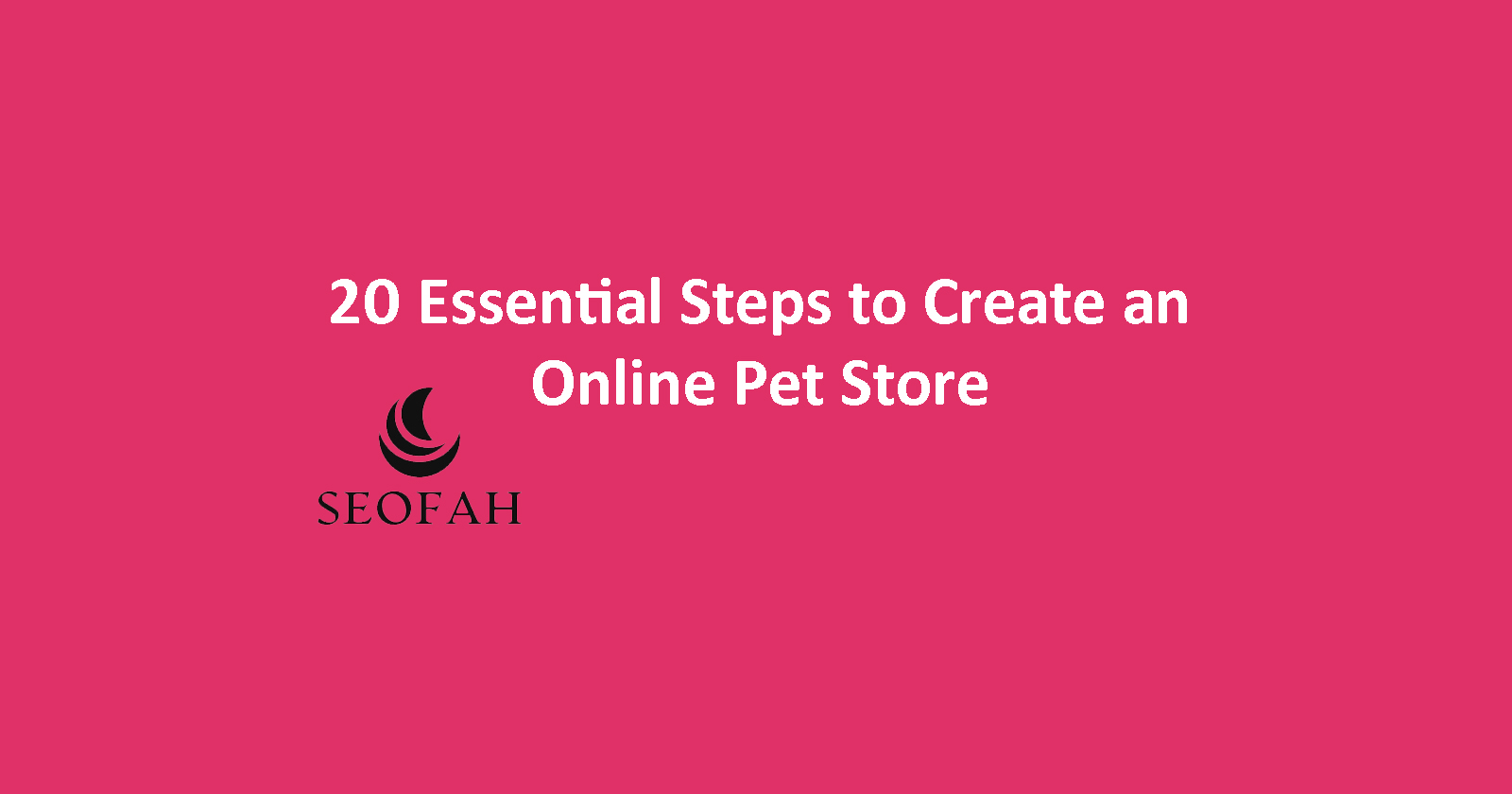Creating an online pet store can be an exciting and lucrative venture, especially in today’s thriving e-commerce landscape. With more people than ever before owning pets and treating them as part of the family, the demand for pet products and services continues to grow. Whether you’re a passionate pet lover looking to turn your hobby into a business or an entrepreneur aiming to tap into the pet industry’s potential, establishing an online pet store requires careful planning and execution.

In this comprehensive guide, we will walk you through the 20 essential steps to create an online pet store successfully. From initial planning and market research to website development, product sourcing, marketing strategies, and customer service, each step plays a crucial role in building a strong foundation for your online business.
Step 1: Research the Pet Industry and Define Your Niche
Before diving into the process of creating your online pet store, it’s crucial to conduct thorough research on the pet industry. Understand the current market trends, consumer behavior, popular pet products, and emerging niches. Define your niche based on your interests, expertise, and market demand—whether it’s focusing on specific pet types (e.g., dogs, cats, reptiles) or specialized products (e.g., organic pet food, designer pet accessories).
Step 2: Conduct Market Analysis and Identify Your Target Audience
Once you’ve identified your niche, conduct a comprehensive market analysis to assess the competitive landscape. ldentify key competitrs, their strengths, weaknesses, and markt positioning. AnaIyze your targt audience—pet owners, pet enthusiasts, or specific demographic segments (e.g., urban pet owners, luxury pet product consumers). Understand their needs, preferences, purchasing behaviors, and pain points to tailor your offerings effectively.
Step 3: Create a Detailed Business Plan
A well-structured business plan is essential for guiding your online pet store’s development and growth. Outline your business objectives, mission statement, target market demographics, competitive analysis, product offerings, pricing strategy, sales and marketing plan, operational logistics, financial projections, and milestones. A clear business plan will serve as a roadmap and help you secure funding if needed.
Step 4: Choose a Unique Brand Name and Secure Your Domain
Select a distinctive and memorable brand name that reflects your online pet store’s identity, values, and offerings. Ensure the chosen name is available as a domain name and secure it with a .com extension for credibility and accessibility. Your brand name and domain should be easy to spell, pronounce, and remember to enhance brand recognition and customer recall.
Step 5: Register Your Business and Obtain Necessary Licenses
Register your online pet store as a legal entity, such as a sole proprietorship, partnership, LLC (Limited Liability Company), or corporation, depending on your business structure and legal requirements. Obtain any necessary business licenses, permits, tax identification numbers, and comply with local, state, and federal regulations related to e-commerce, pet products, and sales tax.
Step 6: Develop Your Online Storefront
Create a professional and user-friendly website for your online pet store. Choose a reliable e-commerce platform (e.g., Shopify, WooCommerce, BigCommerce) that meets your business needs and offers customizable templates, secure payment gateways, inventory management, and shipping options. Design your website layout, navigation, product categories, and pages (e.g., Home, About Us, Products, Contact) with a mobile-responsive design for seamless browsing across devices.
Step 7: Source High-Quality Pet Products and Suppliers
Identify reputable suppliers, manufacturers, and distributors of pet products within your niche. Establish partnerships with suppliers that offer high-quality pet food, treats, toys, grooming supplies, accessories, healthcare products, and other essentials. Negotiate pricing, terms of sale, minimum order quantities, and shipping logistics to ensure product availability, competitive pricing, and reliable inventory management.
Step 8: Set Up Inventory Management and Fulfillment Systems
Implement efficient inventory management systems to track stock levels, monitor product demand, and automate reorder processes. Choose fulfillment options, such as self-fulfillment, third-party logistics (3PL) providers, or dropshipping, based on your business scale, budget, and logistical capabilities. Ensure seamless order processing, packaging, shipping, and delivery to provide a positive customer experience and minimize fulfillment errors.
Step 9: Establish Pricing Strategies and Payment Methods
Develop competitive pricing strategies based on product costs, market demand, competitor pricing, and perceived value to attract customers while ensuring profitability. Offer flexible payment methods, including credit/debit cards, digital wallets (e.g., PayPal, Apple Pay), buy now, pay later (BNPL) options, and secure checkout processes to accommodate diverse customer preferences and enhance transaction security.
Step 10: Implement Effective Marketing and Promotional Strategies
Create a comprehensive marketing plan to promote your online pet store and attract target customers. Utilize digital marketing channels, including search engine optimization (SEO), pay-per-click (PPC) advertising, social media marketing (SMM), email marketing campaigns, influencer partnerships, content marketing (e.g., blogs, videos), and affiliate marketing programs. Leverage seasonal promotions, discounts, loyalty rewards, referral programs, and cross-promotional strategies to drive traffic, increase conversions, and build customer loyalty.
Step 11: Optimize Your Website for Search Engines (SEO)
Optimize your website content, product descriptions, meta tags, URLs, and images with relevant keywords and phrases to improve organic search engine rankings and visibility. Conduct keyword research to identify popular search terms related to pet products, pet care tips, and pet trends. Implement SEO best practices, such as mobile optimization, fast loading speeds, secure HTTPS protocols, and user-friendly navigation to enhance user experience and attract qualified traffic.
Step 12: Create Compelling Product Descriptions and Visual Content
Craft detailed and persuasive product descriptions that highlight key features, benefits, sizes, colors, and ingredients to inform and engage potential customers. Use high-quality images, videos, and 360-degree product views to showcase product appearance, functionality, and usage scenarios. Include customer reviews, testimonials, ratings, and user-generated content (UGC) to build credibility, trust, and social proof.
Step 13: Build a Strong Social Media Presence
Establish active profiles on popular social media platforms, such as Facebook, Instagram, Twitter, Pinterest, and TikTok, to engage with pet owners, enthusiasts, and potential customers. Create compelling content, including pet care tips, product demonstrations, behind-the-scenes stories, user-generated content (UGC), contests, and interactive polls to foster community engagement and brand advocacy. Collaborate with pet influencers, veterinarians, groomers, and pet-related organizations to expand your reach, increase brand awareness, and drive website traffic.
Step 14: Implement Customer Relationship Management (CRM) Systems
Deploy CRM software to manage customer interactions, track purchase history, preferences, feedback, and communication channels (e.g., email, live chat, social media). Personalize marketing campaigns, product recommendations, and promotional offers based on customer behavior, demographics, and lifecycle stages to enhance customer satisfaction, retention, and lifetime value. Respond promptly to customer inquiries, resolve issues, and solicit feedback to improve service quality and strengthen relationships.
Step 15: Monitor Analytics and Performance Metrics
Utilize web analytics tools (e.g., Google Analytics, Adobe Analytics) to track website traffic, visitor behavior, conversion rates, sales performance, and marketing campaign effectiveness. Analyze key performance indicators (KPIs), such as bounce rate, average order value (AOV), customer acquisition cost (CAC), return on investment (ROI), and customer lifetime value (CLV), to identify strengths, weaknesses, opportunities, and threats (SWOT). Make data-driven decisions, optimize marketing strategies, and allocate resources effectively to achieve business objectives and growth milestones.
Step 16: Provide Exceptional Customer Service and Support
Deliver superior customer service experiences through responsive communication, knowledgeable support staff, and proactive issue resolution. Offer multiple customer support channels, including email, phone, live chat, and social media, with extended service hours to accommodate diverse time zones and customer preferences. Train customer service representatives to empathize with pet owners, address inquiries, provide product recommendations, process returns, and ensure customer satisfaction at every touchpoint.
Step 17: Enhance Website Security and Data Privacy
Prioritize website security measures, such as SSL encryption, secure payment gateways (e.g., PCI DSS compliance), firewall protection, and malware detection software, to safeguard customer data, payment information, and confidential business information. Comply with data privacy regulations (e.g., GDPR, CCPA) by obtaining customer consent for data collection, processing, and storage. Educate employees on cybersecurity best practices, monitor website vulnerabilities, and implement regular security audits to mitigate risks and prevent potential security breaches.
Step 18: Expand Your Product Offering and Diversify Revenue Streams
Continuously expand your product assortment by introducing new pet products, seasonal collections, exclusive brands, and limited-edition items to attract repeat customers and stimulate purchase behavior. Diversify revenue streams by offering additional services, such as pet grooming, training classes, veterinary consultations, pet boarding, subscription boxes, and pet insurance referrals. Explore partnerships with complementary businesses (e.g., pet-friendly hotels, travel agencies, pet photographers) to cross-promote products/services and reach new customer segments.
Step 19: Monitor Industry Trends and Adapt to Market Changes
Stay informed about emerging pet industry trends, technological advancements, consumer preferences, regulatory updates, and competitive developments through industry publications, market research reports, trade shows, and networking events. Proactively adapt your business strategies, product offerings, marketing campaigns, and operational processes to capitalize on opportunities, mitigate risks, and maintain competitive advantage in a dynamic marketplace. Foster innovation, creativity, and agility within your team to drive continuous improvement and sustainable growth for your online pet store.
Step 20: Evaluate Performance, Seek Feedback, and Plan for Growth
Regularly evaluate your online pet store’s performance against predefined goals, KPIs, and benchmarks to measure progress, identify areas
for improvement, and celebrate achievements. Solicit customer feedback through surveys, reviews, and social media engagement to gain insights into customer satisfaction, product preferences, and brand perception. Use feedback to refine product offerings, enhance service quality, and implement customer-driven improvements. Develop a strategic growth plan with expansion initiatives, new market entry strategies, strategic partnerships, and investment opportunities to scale your online pet store operations and achieve long-term success.
Conclusion
Creating a successful online pet store requires careful planning, strategic execution, and continuous adaptation to meet evolving market demands, consumer expectations, and industry trends. By following the 20 essential steps outlined in this guide—from conducting market research and defining your niche to developing a user-friendly website, sourcing high-quality products, implementing effective marketing strategies, and providing exceptional customer service—you can establish a strong foundation for your online pet store’s growth and profitability.
Remember that building a reputable brand, fostering customer loyalty, and delivering value-added experiences are key to differentiating your online pet store from competitors and achieving sustainable success in the competitive e-commerce landscape. Embrace innovation, embrace innovation, and embrace innovation






[…] needing advanced technical knowledge. Whether you’re starting a blog, portfolio site, or an online store, WordPress.com offers scalability and […]